

The ICE 3 is the third generation of the ICE, with some radical changes to previous generations. The higher top speed (330 km/h) and steeper grades (4 %) of future high speed lines such as Köln - Frankfurt made it necessary to install power in more carriages of the train. So, the choice was taken to distribute the power over the whole train, rather than concentrating it in one or two power units. The ICE 3 will be an eight-car `half train' with 16 powered axles which can operate in double traction like the ICE 2 (and even together with it).
Testing of first ICE 3 vehicles started in fall 1998. The first ICE 3 trains were delivered to the DB Reise&Touristik AG and NS Reizigers BV near the end of 1999 and started regular service in May 2000. The high speed line Köln - Frankfurt will probably be opened in 2002, with five ICE 3 per hour.
Other than the ICE 1 and ICE 2, which were designed for domestic service, the ICE 3 comes in versions for one and four current systems and has a slightly narrower profile for international operation throughout continental Europe. The international ICE 3 will be delivered with the signalling systems of the Netherlands, Germany and Switzerland, but can be easily extended to run in other countries (Belgium, France, Italy) as well.
37 single-system trains (class 403) and 13 four-system trains (class 406) are in service or still being delivered for the DB AG. 4 four-system trains (class 406, NS number 4651 to 4654) have been delivered to the NS. One ICE 3 costs 40 million DM for the single system version, 42 million DM for the multi-system version. Meanwhile the DB AG signed a letter of content with the industry about the delivery of 13 more ICE 3 trains - these might have some differences to the trains already in service.
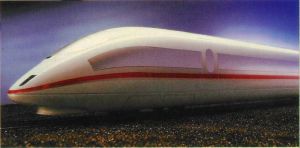 The styling was created by Alexander Neumeister, who is responsible for
the visual characteristics of the whole ICE family, as he designed the
ICE-V. The picture shows one of the first models.
The styling was created by Alexander Neumeister, who is responsible for
the visual characteristics of the whole ICE family, as he designed the
ICE-V. The picture shows one of the first models.
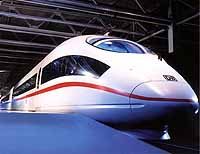 A 1:1 model of a half ICE 3 end car was built for completing the
design in every detail before actually building the train, this model is
now exhibited in the transport museum
in Nürnberg. A number of details were changed from this model in the actual
train.
A 1:1 model of a half ICE 3 end car was built for completing the
design in every detail before actually building the train, this model is
now exhibited in the transport museum
in Nürnberg. A number of details were changed from this model in the actual
train.
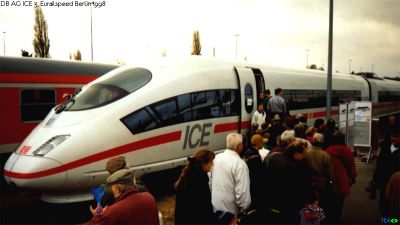
The ICE 3 is an 8-car train with no more locomotive (the traction equipment is spread over the entire train). The carriages are shorter and narrower than those of the ICE 1 and ICE 2. The front is more streamlined, and instead of the two rectangular front windows, it now has one large oval window. The passengers in the first and last car have the possibility to look out through the cab. The tilting InterCity train ICT for classic lines has the same general front arrangement, but with a steeper, less streamlined shape. The photo shows the ICE 3 during its first public presentation at the Eurailspeed (Berlin, November 1998).
The 1950 mm wide pantographs for the German and Austrian AC system will
be installed on the 2nd and 7th car, the 1450 mm wide pantographs for the
Swiss, French and future Belgian AC systems on the 4th and 5th car. The
version for multiple current systems will also have pantographs for the DC
systems (1500 V and 3000 V) on the 3rd and 6th car. In AC systems, thanks
to a high-voltage cable, only one pantograph needs to be raised (the one
in front for the first train of a double consist, otherwise the rear
pantograph), in DC systems both pantographs of each trainset are needed
due to the higher amperages.
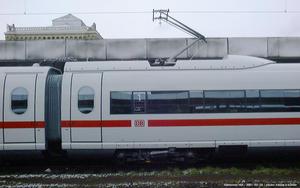 Aerodynamic shrouding of the pantographs (to reduce wind noise and air
resistance) similar to Japanese Shinkansen trains has been installed on
all ICE 3 after the first tests.
Aerodynamic shrouding of the pantographs (to reduce wind noise and air
resistance) similar to Japanese Shinkansen trains has been installed on
all ICE 3 after the first tests.
This floor plan by Siemens shows an earlier version of the international ICE 3 (class 406), meanwhile the interior has been optimized a bit, resulting in a few more seats.
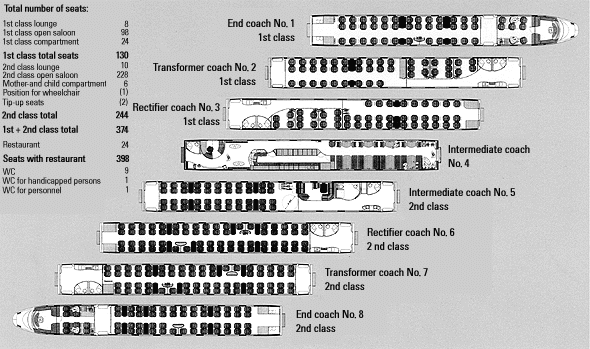
This is a ground plan with the seat numbers of the ICE 3 cars class 403 (single system version). If you compare it to the above picture, you can see the additional doors in the third and fifth car.
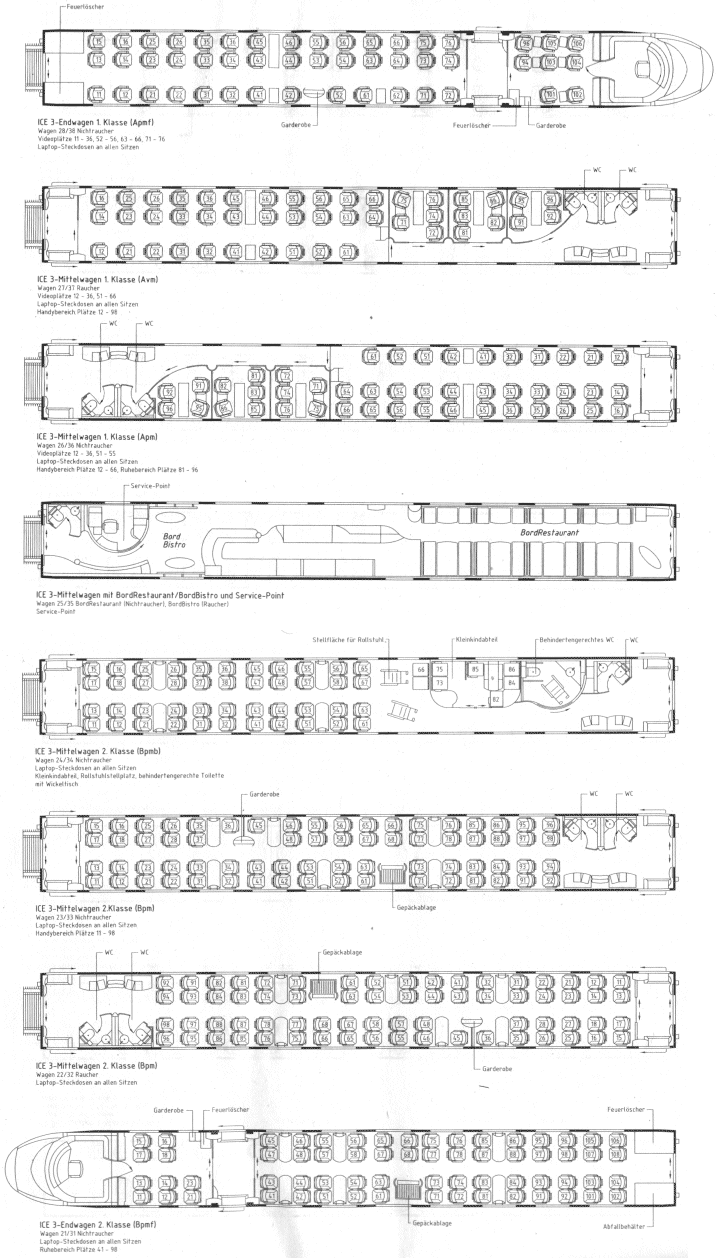
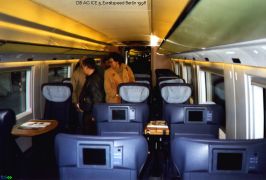
As passengers have criticized the lack of compartments in the ICE 2,
six compartments of four or five seats are located in 1st class. They are
separated by walls of a sandwich construction with wood veneer and have
glass doors to the side corridor. Each compartment has a large wooden table.
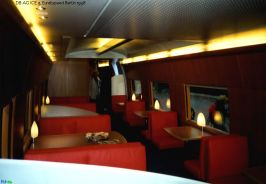
The kitchen is similar to the ICE 1 and ICE 2. As the train
guard's compartment (in new "counter" style) is now located in the dining-car,
the BordTreff (snack bar) area has been reduced in size, with no more seats,
just two small tables for standing passengers.
The coach next to the BordRestaurant is equipped with a family compartment (six seats with a table, a playing area for children and extra storage room). Also in this coach is space for passengers in wheelchairs (with folding seats) and an extra large toilet suitable for handicapped persons.
| 1st class | 2nd class | |
| Seat pitch (row seat) | 1010 mm | 971 mm |
| Knee space (row seat) | 889 mm | 859 mm |
| Seat width | 500 mm | 465 mm |
| Aisle width (open) | 680 mm | 554 mm |
| railway | class | ordered | year | current systems |
| 403 (1st series) | 37 | 1999 | 15 kV 16.7 Hz | |
| 403 (2nd series) | 13 | 2001 | 15 kV 16.7 Hz | |
| 406 | 13 | 1999 | 15 kV 16.7 Hz, 25 kV 50 Hz, 1.5kV =, 3 kV = | |
| 406 | 4 | 1999 | 15 kV 16.7 Hz, 25 kV 50 Hz, 1.5kV =, 3 kV = | |
| 16 | 2002 | 25 kV 50 Hz | ||
With four additional trains of the multi-system version delivered to the
NS (Nederlandse Spoorwegen), this is the first ICE to be exported
outside Germany. The four NS trains are internally and externally identical
to those of the DB AG, including the same livery (white with red stripe), and
can only be distinguished by their dark blue ![]() logos (at the same location as the
logos (at the same location as the ![]() logos). They will also be included in the DB AG
numbering system (406 x51-y to 406 x54-y, where
x is the type of the coach and y is the redundancy check digit).
logos). They will also be included in the DB AG
numbering system (406 x51-y to 406 x54-y, where
x is the type of the coach and y is the redundancy check digit).
The option of 50 more ICE 3 trainsets has been converted into an order for 14 more trains on 1999-03-16.
| No. | class | interior | technical |
| (1) | 4030 | 49 seats 1st cl (observation lounge: 8, open: 41), cab, 2 doors | 1 inverter, 4 traction motors |
| (2) | 4031 | 46 seats 1st cl (compartments: 14, open: 32), 2 WC, 4 doors | AC pantograph, transformer |
| (3) | 4032 | 46 seats 1st cl (open: 32, compartments: 14), 2 WC, 4 doors | 1 inverter, 4 traction motors |
| (4) | 4033 | dining-car with 24 seats, kitchen with 2 doors, stand-up bar, crew compartment, staff WC | batteries |
| (5) | 4038 | 52 seats 2nd cl (open: 46, family compartment: 6), large WC, 4 doors | batteries, pneumatic equipment |
| (6) | 4037 | 68 seats 2nd cl (open), 2 WC, 4 doors | 1 inverter, 4 traction motors |
| (7) | 4036 | 68 seats 2nd cl (open), 2 WC, 4 doors | AC pantograph, transformer |
| (8) | 4035 | 60 seats 2nd cl (observation lounge: 10, open: 50), cab, 2 doors | 1 inverter, 4 traction motors |
Capacity: 141 seats 1st class (37%), 248 seats 2nd class (63%), 24 seats restaurant
| No. | class | interior | technical |
| (1) | 4060 | 46 seats 1st cl (observation lounge: 8, open: 38), cab, 2 doors | 1 inverter, 4 traction motors |
| (2) | 4061 | 44 seats 1st cl (compartments: 14, open: 30), 4 doors | AC pantograph, transformer |
| (3) | 4062 | 46 seats 1st cl (open: 32, compartments: 14), 2 doors | DC pantograph, 1 inverter, 4 traction motors |
| (4) | 4063 | dining-car with 24 seats, kitchen with 2 doors, stand-up bar, crew compartment, staff WC | narrow AC pantograph, batteries |
| (5) | 4068 | 52 seats 2nd cl (open: 46, family compartment: 6), large WC, 4 doors | narrow AC pantograph, batteries, pneumatic equipment |
| (6) | 4067 | 68 seats 2nd cl (open), 2 WC, 2 doors | DC pantograph, 1 inverter, 4 traction motors |
| (7) | 4066 | 66 seats 2nd cl (open), 2 WC, 4 doors | AC pantograph, transformer |
| (8) | 4065 | 56 seats 2nd cl (observation lounge: 10, open: 46), cab, 2 doors | 1 inverter, 4 traction motors |
Capacity: 136 seats 1st class (36%), 242 seats 2nd class (64%), 24 seats restaurant
Due to the additional equipment installed in cubicles inside six cars, the international version has 11 seats and 4 doors less than the domestic version.
First, the ICE 3 will not have a separate power unit anymore, instead the traction equipment is now spread over the whole train as described in the `train composition' above.
Second, it is designed to be operated internationally, so it has to conform to the Technical Specifications of Interoperability - this means that a full train (two coupled ICE 3 sets) can't be longer than 400 m, the axle load may not exceed 17 t, entrances must be easily accessible from 0.55 m and 0.76 m high platforms, the profile must fit into the loading gauge UIC 505, and of course the train has to be compatible to the electricity, signalling and communication systems of the lines that it will use. This includes the French and Belgian high speed lines. The total train length of 400 m and the UIC 505 loading gauge mean that the cars of the ICE 3 will be shorter and narrower than those of the ICE 1 and ICE 2, this also allows a weight reduction of the structure necessary to keep the axle load within the given limit of 17 t despite the addition of drive equipment. Nevertheless the carbodies of the ICE 3 will be more rigid than those of the ICE 2.
The drive of the 8 powered bogies follows the principle used in the Japanese Shinkansen trains. This is the first application of this kind of drive in Europe. The 1st, 3rd, 6th and 8th carriage are each driven by four 500 kW traction motors, giving a total power of 8 MW in AC systems. Each powered car is supplied by one water-cooled GTO inverter for all four traction motors, these are installed in the 3rd and 6th carriage.
The bogies have a primary suspension with two coil springs per axle and a secondary suspension with two pneumatic springs per bogie, with 118 litres additional air volume and rubber springs as emergency suspension (if the pneumatic springs should be out of air).
The ICE 3 will be the first series train equipped with an eddy-current brake that ensures braking the train mostly free of wear. Also, thanks to the higher number of powered axles, the regenerative electric brake can be used more efficiently. Still, the ICE 3 will be equipped with disc brakes.
To reduce train weight, the air-conditioning system will use air as a cooling medium, similar to systems used in aeroplanes. This system also reduces maintenance costs, however the energy consumption will be slightly higher.
As the ICE-V, the ICE 3 will have dampening elements between the carbodies to improve the comfort for passengers.
| end car | middle car | train (403) | train (406) | |
| length | 25.835 m | 24.775 m | 200.32 m | |
| width | 2.95 m | |||
| height | 3.89 m | |||
| mass (empty) | 409 t | 435 t | ||
| seats (total) | 415 | 404 | ||
| power (cont.) | 8000 kW | 8000 kW
(AC) 4300 kW (DC) | ||
| tractive effort | 300 kN | |||
| top speed | 330 km/h | 330 km/h
(AC) 220 km/h (DC) | ||
| mass/length | 2.042 t/m | 2.172 t/m | ||
| mass/seat | 0.986 t/seat | 1.077 t/seat | ||
| power/mass | 19.56 kW/t | 18.39 kW/t
(AC) 9.89 kW/t (DC) | ||
| power/seat | 20.46 kW/seat | 21.05
kW/seat (AC) 11.32 kW/seat (DC) | ||
| Total area | 509 m² | |||
| Passenger area | 342.36 m² | |||
The first plans of an ICE for multiple current systems came up even before the ICE 1 was in operation. It would have been called ICE-M (InterCity Europa Mehrsystem = multiple system) and consist of two lightweight power cars and six middle cars (two 1st class, restaurant and three 2nd class). It was necessary to have two power cars for six middle cars because the weight of the power cars could not exceed 68 t due to weight limits on French TGV lines. The train was planned for a total power of 7200 kW in the AC systems and 5000 kW in the DC systems, with a capacity of 350 to 370 passengers. A high voltage cable would supply both power cars with energy from one pantograph. Two ICE-M could have been coupled together. It is also necessary to build narrower carbodies to be compatible with the international loading gauge.
It was planned to test two or three prototypes from 1993 on and start regular service on the lines Amsterdam - Köln - Frankfurt (M) - Switzerland/Austria and Frankfurt (M) - Brussels in 1995 with 20 trains. Also, the ICE-M was one of the candidates for the Paris - Brussels - Köln line of the THALYS system. After the decision to use TGV variants on both THALYS lines, the project was shelved - the original ICE-M concept clearly showed the limitations of a train with separate power cars.
As the high speed lines Hannover - Würzburg and Mannheim - Stuttgart have shown, the operation of both freight trains and high speed trains on a line with flat grades is not without problems. Loads of freight trains could be damaged when meeting a high speed train in a tunnel, and the capacity of a line is reduced when it is used by trains of significantly different travelling speeds. So, when the high-speed line Köln - Frankfurt was planned, it was decided to build it as a pure high-speed passenger line - which also allowed to build steeper grades (up to 4%), which helped saving money (fewer tunnels and bridges necessary). Such a steep line also requires powerful trains with a greater number of powered axles.
Another factor was linked to the former federal railway's rôle as a supporter (and almost only customer) of the railway industry. EMUs used to be unpopular in the seventies and eighties, because they were mostly manufactured by the carriage industry, with only a few components from the locomotive industry - a train with separate power cars brought orders to both branches. Meanwhile the railway industry has been reorganized, with manufacturers such as Adtranz, Siemens, Bombardier and Alstom who can build (almost) everything, so this kind of consideration is no longer necessary.
The high-speed line Köln - Frankfurt will open in 2002 - then all ordered
ICE 3 trains are needed for the lines via this section.
ICE 3 for Spain
On 2001-03-24, the Spanish railway operator Renfe decided to order 32 high-speed trains (for
up to 350 km/h) for the new-built high speed line Madrid - Barcelona, which
will go into service from 2002 to 2004:
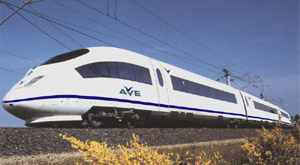 16 trains will come from Siemens
(with various sub-contractors, amounting to a local content of 70 %
manufactured in Spain), these are 8-car trains like the ICE 3 in
Germany and Netherlands, but with more power (9000 kW, 21.5 kW/t) and a
capacity of 404 passengers (probably no dining-car and perhaps a higher
share of 2nd class).
16 trains will come from Siemens
(with various sub-contractors, amounting to a local content of 70 %
manufactured in Spain), these are 8-car trains like the ICE 3 in
Germany and Netherlands, but with more power (9000 kW, 21.5 kW/t) and a
capacity of 404 passengers (probably no dining-car and perhaps a higher
share of 2nd class).
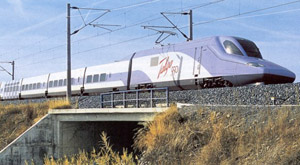 16 trains of the type Talgo 350 will come from Talgo, with Adtranz and Siemens Krauss-Maffei as subcontractors for
the power cars. Ten of the power cars will be built in Germany, the rest in
Spain. These trains will consist of two power cars and twelve middle cars,
have a power of 4000 kW per power car (24.7 kW/t) and a capacity of 318 seats.
16 trains of the type Talgo 350 will come from Talgo, with Adtranz and Siemens Krauss-Maffei as subcontractors for
the power cars. Ten of the power cars will be built in Germany, the rest in
Spain. These trains will consist of two power cars and twelve middle cars,
have a power of 4000 kW per power car (24.7 kW/t) and a capacity of 318 seats.
For more informations about the AVE rolling stock (ordered trains as well as those already in service), see the AVE page of Bertram Wlasak, who has also created the above photo of an ICE 3 in AVE colours.
Trix will sell a DC version of the märklin H0 ICE 3, which will look exactly the same as the märklin train, and also come in the same sets.
Roco had announced an "exclusive" model of the ICE 3, exactly to 1:87 scale, in both DC and AC systems. They gave up those plans however, and are now offering the ICE-VT instead.